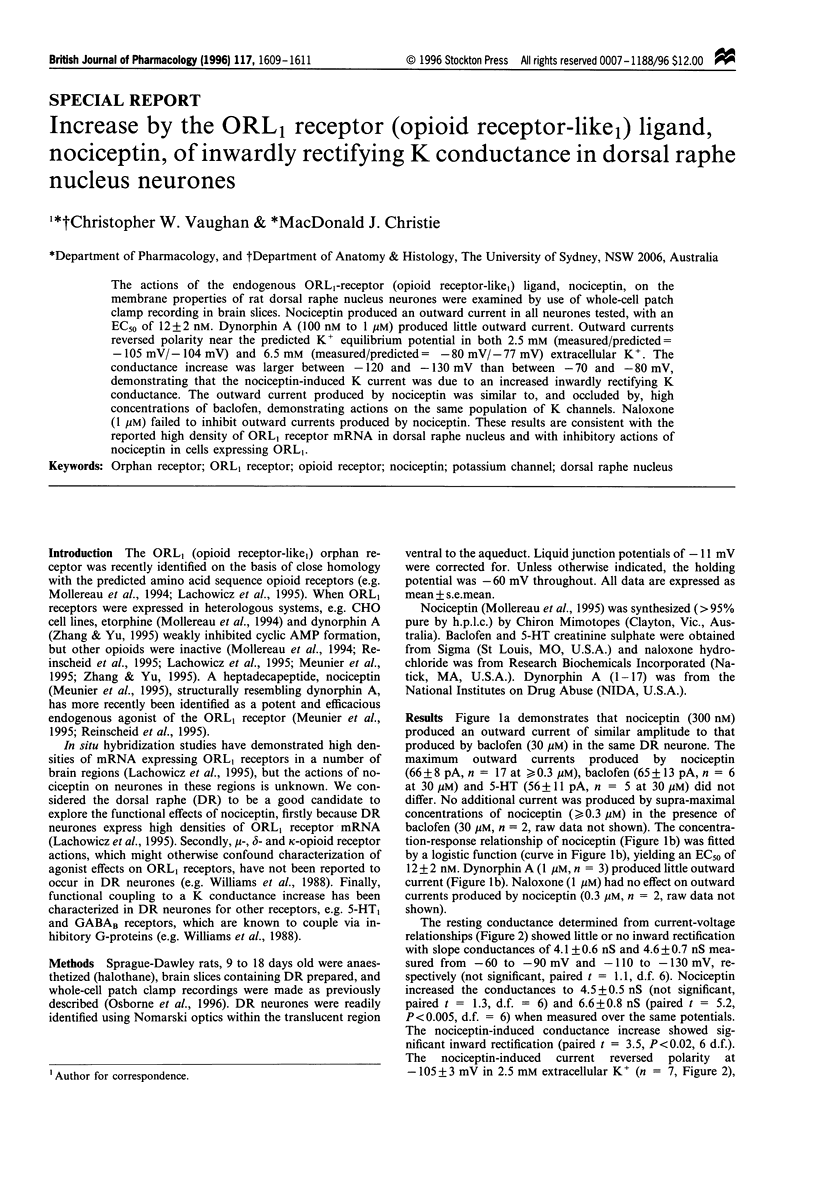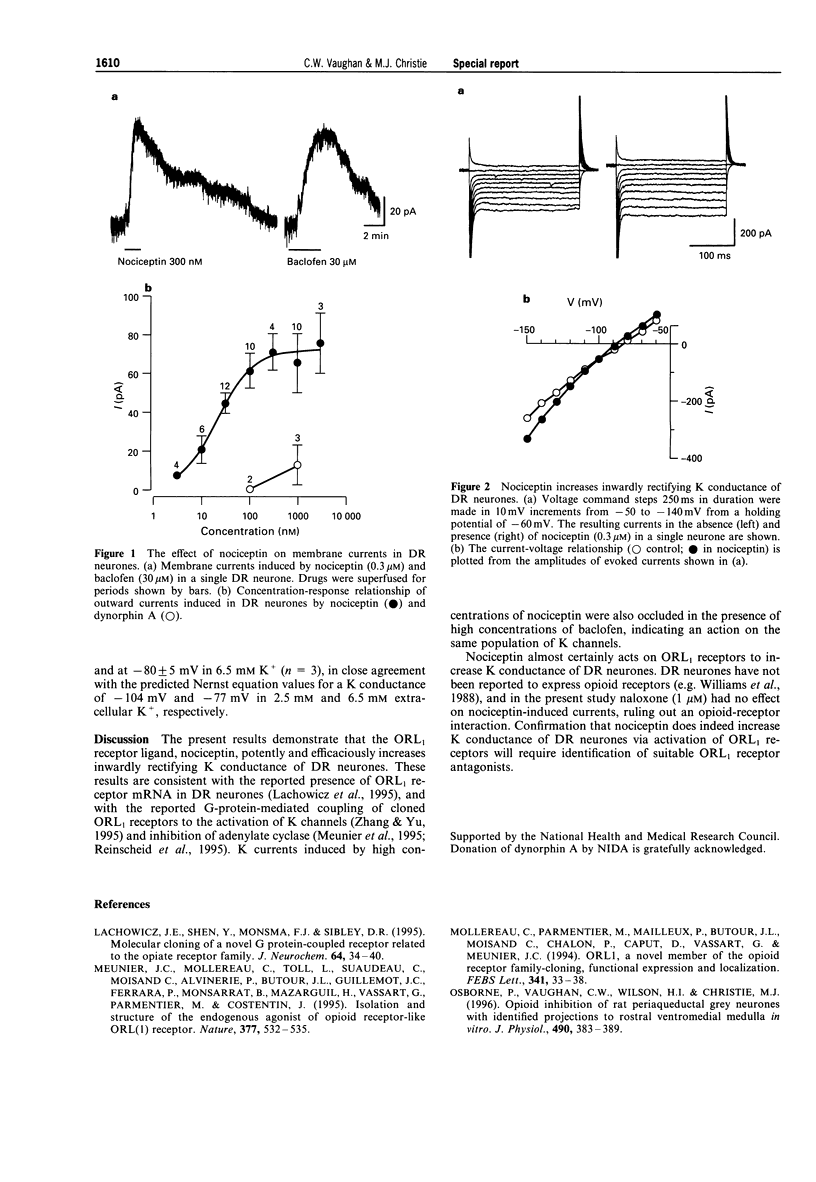Abstract
The actions of the endogenous ORL1-receptor (opioid receptor-like1) ligand, nociceptin, on the membrane properties of rat dorsal raphe nucleus neurones were examined by use of whole-cell patch clamp recording in brain slices. Nociceptin produced an outward current in all neurones tested, with an EC50 of 12 +/- 2 nM. Dynorphin A (100 nM to 1 microM) produced little outward current. Outward currents reversed polarity near the predicted K+ equilibrium potential in both 2.5 mM (measured/predicted = -105 mV/-104 mV) and 6.5 mM (measured/predicted = -80 mV/-77 mV) extracellular K+. The conductance increase was larger between -120 and -130 mV than between -70 and -80 mV, conductance. The outward current produced by nociceptin was similar to, and occluded by, high concentrations of baclofen, demonstrating actions on the same population of K channels. Naloxone (1 microM) failed to inhibit outward currents produced by nociceptin. These results are consistent with the reported high density of ORL1 receptor mRNA in dorsal raphe nucleus and with inhibitory actions of nociceptin in cells expressing ORL1.
Full text
PDF


Selected References
These references are in PubMed. This may not be the complete list of references from this article.
- Lachowicz J. E., Shen Y., Monsma F. J., Jr, Sibley D. R. Molecular cloning of a novel G protein-coupled receptor related to the opiate receptor family. J Neurochem. 1995 Jan;64(1):34–40. doi: 10.1046/j.1471-4159.1995.64010034.x. [DOI] [PubMed] [Google Scholar]
- Meunier J. C., Mollereau C., Toll L., Suaudeau C., Moisand C., Alvinerie P., Butour J. L., Guillemot J. C., Ferrara P., Monsarrat B. Isolation and structure of the endogenous agonist of opioid receptor-like ORL1 receptor. Nature. 1995 Oct 12;377(6549):532–535. doi: 10.1038/377532a0. [DOI] [PubMed] [Google Scholar]
- Mollereau C., Parmentier M., Mailleux P., Butour J. L., Moisand C., Chalon P., Caput D., Vassart G., Meunier J. C. ORL1, a novel member of the opioid receptor family. Cloning, functional expression and localization. FEBS Lett. 1994 Mar 14;341(1):33–38. doi: 10.1016/0014-5793(94)80235-1. [DOI] [PubMed] [Google Scholar]
- Osborne P. B., Vaughan C. W., Wilson H. I., Christie M. J. Opioid inhibition of rat periaqueductal grey neurones with identified projections to rostral ventromedial medulla in vitro. J Physiol. 1996 Jan 15;490(Pt 2):383–389. doi: 10.1113/jphysiol.1996.sp021152. [DOI] [PMC free article] [PubMed] [Google Scholar]
- Reinscheid R. K., Nothacker H. P., Bourson A., Ardati A., Henningsen R. A., Bunzow J. R., Grandy D. K., Langen H., Monsma F. J., Jr, Civelli O. Orphanin FQ: a neuropeptide that activates an opioidlike G protein-coupled receptor. Science. 1995 Nov 3;270(5237):792–794. doi: 10.1126/science.270.5237.792. [DOI] [PubMed] [Google Scholar]
- Williams J. T., Colmers W. F., Pan Z. Z. Voltage- and ligand-activated inwardly rectifying currents in dorsal raphe neurons in vitro. J Neurosci. 1988 Sep;8(9):3499–3506. doi: 10.1523/JNEUROSCI.08-09-03499.1988. [DOI] [PMC free article] [PubMed] [Google Scholar]
- Zhang S., Yu L. Identification of dynorphins as endogenous ligands for an opioid receptor-like orphan receptor. J Biol Chem. 1995 Sep 29;270(39):22772–22776. doi: 10.1074/jbc.270.39.22772. [DOI] [PubMed] [Google Scholar]


